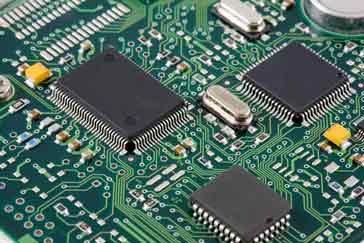PCB Solder Resist
PCB solder resist is applied to virtually all commercially produced printed circuit boards to ensure that solder is present only where required and to protect the PCB surface.
Home » Construction & manufacture » this page
Soldering Tutorial Includes:
Soldering basics
Manual soldering: how to solder
Soldering irons
Tools for soldering
Solder - what it is and how to use it
De-soldering - the secrets of how to do it properly
Solder joints
PCB solder resist
See also: SMT soldering techniques for PCB assembly
PCB solder resist is an essential part of today's printed circuit board technology. The use of PCB solder resist has become so widespread, that it is most unusual to see any printed circuit boards without any solder resist covering, except for some home constructed circuits.
Today even many prototype boards have solder resist and as such its use on commercially manufactured printed circuit boards can be said to be universal.
The PCB solder resist is the coloured covering that is seen on printed circuit boards. Often coloured a rich green, it can actually be virtually any colour with blue and red being other colours that are relatively frequently seen.
The solder resist is applied during the PCB manufacture itself and therefore is not applied later in the process - it is not an option that can be applied at a later stage.

Purpose of PCB solder resist
As its name indicates, a solder resist covering on a board applied during the PCB manufacture process and it is used to protect areas of a printed circuit board, PCB, from taking solder. In this way only areas that actually need to have a solder covering, i.e. areas where components are to be soldered, are free of the solder resist and able to be soldered. This is particularly useful during the PCB assembly stage where boards are soldered.
This provides many advantages. The main one is that only having solder where it is needed, and prevented from reaching some areas by the solder resist, small short circuits caused by solder bridges can be significantly reduced. This is increasingly important because the very fine pitch of many printed circuit boards today means that small solder tracks caused in the soldering process could easily cause bridges and short circuits.
The use of solder resist confines this problem to areas where components are to be soldered, and these areas can be designed accordingly.
In addition to its function in preventing solder from causing small bridges, PCB solder resist also acts as a protective layer to a board. The solder resist provides electrical insulation and protection against oxidation and corrosion. Over periods of time this can improve the overall reliability of a printed circuit board, especially if it is exposed to harmful agents.

What is PCB solder resist?
PCB solder resist is a permanent resin based coating applied to printed circuit boards during the manufacture of the bare printed circuit board. The solder resist is a permanent coating of a resin formulation, generally green in colour, which encapsulates and protects all of the surface features of a printed circuit board except the specific areas where it is required to form solder joints.
Although green is the most widely used colour for solder resist, almost any colour can be used. While it can be difficult to maintain exact colours, it is possible to make them almost any colour. However apart from green, other popular colours are red and blue.
Applying PCB solder resist
In order that PCB solder resist layers are able to meet the very precise requirements of today's surface mount technology, SMT printed circuit boards, Liquid Photo-Imageable, LPI, solder resist is used. Previously PCB solder resist application used stencil printing using a silk screen.
The LPI process for solder resist is very different to the previously used stencil printing. LPI separates the coating and imaging operations, thereby gaining the highest level of precision. The PCB solder resist material used by the bare PCB manufacturer is in the form of a liquid photo-polymer and it uses epoxy or epoxy-acrylate resin technology and the whole board is coated with the material.
The material thickness is typically around 30 microns over the bare board and 20 microns over the copper. Once dry after application of the solder resist material, it is exposed to the image pattern required and then developed to give the required solder resist pattern. Then after developing the solder resist is heat cured to ensure it provides a tough durable finish.
The solder resist used on boards enables only those areas where solder is required to be available to take solder. All the other areas are covered with the protective resist. This means that bridges between lines and pads can be kept to a minimum and the board surface protected from oxidation and other forms of damage.
 Written by Ian Poole .
Written by Ian Poole .
Experienced electronics engineer and author.
More Construction Ideas & Concepts:
Soldering
SMT component soldering
ESD - Electro-Static Discharge
PCB manufacture
PCB assembly
Return to Constructional Techniques menu . . .


